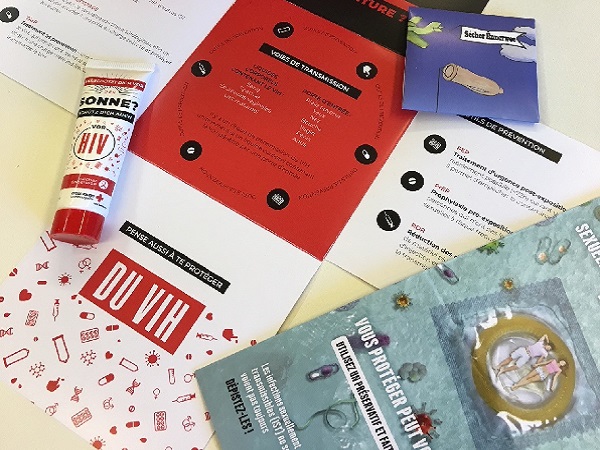 Information and awareness kit provided by the HIV Counselling Service of the Luxembourg Red Cross;
Credit: MSAN
Information and awareness kit provided by the HIV Counselling Service of the Luxembourg Red Cross;
Credit: MSAN
2018 marked the first year since 2013 that the number of new cases of HIV considerably declined in Luxembourg; it was also the first year of the new National HIV Action Plan.
The 2018 Progress Report of the AIDS, Infectious Hepatitis and Sexually Transmitted Infections Surveillance Committee has revealed a significant decrease in new HIV infections in the Grand Duchy: 43 cases compared to 60 in 2017.
This decrease in new infections was found predominantly among men engaging in heterosexual sex (14 in 2018 compared to 31 in 2017) and among intravenous drug users (4 compared to 10). The epidemic among intravenous drug users appears to have been halted and has returned to the same level as in 2010. Indeed, a majority of people living with HIV are currently on antiretroviral (ART) therapy and a great effort has been put in place to monitor these patients so that everyone has the opportunity to take their medication and to avoid stopping their treatment.
Despite this decrease, the report has shown the importance of continuing prevention efforts, not least because drug users represent the group most affected by hepatitis C (72%). Precariousness and homelessness in many cases can make these individuals even more vulnerable.
Luxembourg Minister of Health emphasised: "It is important to me that the National HIV and Hepatitis 2018-2022 Action Plans (PANHEL) continue as inclusive an approach as possible to reach all those who are particularly at risk. Housing research remains a priority today to reintegrate these people as best as possible and to welcome a medical and educational team". In fact, as part of the PANHEL, the various organisations in charge of this vulnerable population have proposed a "low threshold" housing concept for drug users in need of medical care.
On the other hand, 2018 saw an increase in new infections among homosexual and bisexual individuals, with 21 cases compared to 15 in 2017, and this in spite of the implementation of the prevention tool of pre-exposure prophylaxis (PrEP) since 2017. The majority of new infections within this group affected individuals aged 26-35 (11 out of 21 cases).
As AIDS Committee Chair Dr. Carole Devaux explained: "HIV PrEP is taking one tablet a day to avoid infection when the person has reports/behaviors that are at high risk of getting HIV. PrEP has become a major prevention tool in Europe as it also includes condom education, immunisations and regular screening for sexually transmitted infections (STIs)".
118 people are currently under PrEP in Luxembourg with a median age of 37 years. This offer is mainly for men who have sex with men (97%); only one woman is under treatment. No HIV contamination has been reported to date, thanks to regular monitoring. The treatment is reimbursed by the national health fund, the CNS, and provided by the Centre Hospitalier de Luxembourg's pharmacy.
In addition, to facilitate access to the diagnosis of HIV, self-diagnosis tests will soon be available in pharmacies and in a few months also in supermarkets in Luxembourg. This development reinforces the country's commitment to the UN target 90-90-90, that aims for 90% of people living with HIV to be aware of their status by 2020. The sale of thes tests will be accompanied by an information sheet to consumers in French, German, Portuguese and English. Additional information (including details of the Red Cross HIV counselling service) are indicated in the test kit instructions, as well as on the websites www.aids.lu and www.sante.lu.








